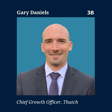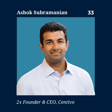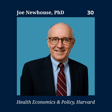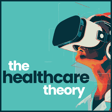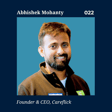Introduction to Amar Seti and Patient Premier
00:00:00
Speaker
Today we're speaking with Amar Seti, who's the founder of Patient Premier, a startup that really changes the way we measure, view and manage pain. So hi Amar, thank you so much for coming on today and welcome to the Healthcare care Theory. nice talk to you.
00:00:12
Speaker
Of course, and I'm super excited to get into your story, but before we actually dive into what Patient Premier does, what you're doing today, i mean, you have a background in anesthesiology and and policy consulting, kind of across the board here.
00:00:24
Speaker
yeah um What kind of brought your interest in like anesthesiology and first place? Right. So it really started, i think, we'll we'll go back to like medical school. I was at UNC and I did an internship up on the Hill in ah Bill Frist's office at the time.
00:00:47
Speaker
There was this big controversy about cloning a sheep named Dolly. And everyone was up in arms but nobody in the legislature really had any clue what was what was going on with fundamental science uh of of cloning a sheep and uh you know particularly on the hill those doomsday scenarios come out and suddenly uh the sheep becomes uh some sort of ah alien uh hybrid life form that's going to take over the earth and
00:01:17
Speaker
So you have to like take information and find a way to calm it down and digest it in order to be a true advocate. And that's that's one of the things you learn when you get up on the hill, how to take something complicated, simplify that message, make it more digestible so that it can be used on a policy level by consumers, by any individual, or really by patients as well.
Transition to Anesthesiology
00:01:40
Speaker
So I was taking that medical knowledge that I got from medical school and translating it into what you can do on the advocacy side. Now, for a number of reasons, I didn't really stick with ah ah the legislative process for advocacy.
00:01:56
Speaker
I really wanted to hone in on what I wanted to do in medical school. I wanted to more effectively treat and manage my patients. And And that that really comes down to like, what are your passions? What are your interests as you get through medical school? And these things evolve and change over time.
00:02:13
Speaker
So you never want to go into undergrad or grad school assuming you know exactly where your pathway is going to end up. Because my story, if it reflects you know the realm of possibilities out there, is one in which I've made many changes over the years to end up where where I was.
00:02:31
Speaker
So I initially actually had a very big interest in neurology, sleep sleep medicine, ah sleep physiology, and the basic science of neurology. And one thing you realize when you like the science of neurology is that, and particularly at the time that I trained There aren't that many options for what you can do to treat a stroke, to manage epilepsy, ah to manage a lot of neurodegenerative disorders.
00:03:01
Speaker
Think of ALS, that kind of thing. It tends to be more symptom management. It tended to be more... triage and improving life care and life expectancy rather than any kind
Business Side of Medicine
00:03:16
Speaker
of intervention. And so I found myself very interested in the ah physiology and the science of neurology, but not necessarily the practice of neurology.
00:03:26
Speaker
And that's kind of, at the same time, I started learn about anesthesiology, how interventional it is, how we're on a second by second basis, really controlling, um, lungs, the heart, uh, in turn, the brain, in, in so many different ways.
00:03:42
Speaker
and, uh, the, uh, uh, ah Luckily, most of the time things go very well, particularly have a very well-constructed plan and approach each patient individually and do a good job.
00:03:56
Speaker
Things generally go well, but patients are unpredictable. ah Healthcare care on a patient-by-patient basis can be unpredictable. And so you have to be ready for anything and in anesthesia when you're ready for stuff.
00:04:10
Speaker
things go up and down very quickly. It's a very exciting, lot of procedures, and and that kind of drifted me towards there where I could combine those two worlds. And that kind of extended introduction ah really sets the stage for where I went to after practice, constantly is saying,
00:04:30
Speaker
All right, well, I understand the science here, but behind the science, there's this world of medicine that defines almost everything. i'm a World of business, sorry, that defines almost everything that we do medicine.
00:04:46
Speaker
And yet we're never taught about it in medical school. And people don't really learn about it. If we have to optimize our careers physicians, we need to start learning these things.
Consulting and Private Equity in Healthcare
00:04:55
Speaker
So I started to kind of self-teach myself.
00:04:58
Speaker
What is it to to bill? What is it to collect? How do you manage billing and collections? How do you do it and and ah in a way that you can improve your practice, but not necessarily upset your patients or your referring physicians? These are surgeons we work with or the hospitals that we work with.
00:05:17
Speaker
So there's there's a lot of balance there. At the same time, there's some competing trends in the world of medicine where practices were consolidating. They're being bought out.
00:05:27
Speaker
Private equity was financing a lot of this. So there's a much bigger world of finance and business outside of the the process of managing a group that I started to get.
Founding Patient Premier and Tackling the Opioid Crisis
00:05:40
Speaker
in tune and become a consultant and ah started doing consulting in in anesthesia for group management, for hospital group relationships, and eventually for kind of private equity buyouts of anesthesia groups.
00:05:55
Speaker
Had some success, me and a partner, and we tried to market that. And then this is the first that I'll mention of this is that you You reach a point where you can do one thing or another thing, and you wonder, do I work better by doing both things, by staying active in clinical medicine and and and and that, or do I need to go full time as a consultant? What's the best road? What's going to give me the best long term outcome?
00:06:26
Speaker
We ended up putting a lot of what we made into marketing, trying to build up ah different business lines and and really trying to push it. ah But in the end, we found that our best return on investment in time was to stick with our clinical practice. So we didn't really reinvest in that much.
00:06:46
Speaker
I took that advocacy experience and now this business experience and
00:06:53
Speaker
we I was involved as the president of the Maryland Society of Anesthesia and a lot of work around opioids, opioid policy, the harm of opioids, particularly around ER admissions, around high rates and of of death associated with opioids, particularly spicot more.
00:07:14
Speaker
we We switched from prescription opioids being the number one ah problem to now fentanyl-laced opioids, ah both pills and injectables that started really around 2014 through 2016, caused this massive spike in opioid-related deaths.
00:07:34
Speaker
and saying what can we do to improve the process so that people don't get hooked on opioids and we can help manage patients who are using opioids safely so that they don't have problems in the future.
00:07:54
Speaker
And that led me and my partner, Brian, who's an anesthesiologist, pain medicine expert down in Vanderbilt now, who was originally at Hopkins, to come up with the idea of patient premier and what we call pain score, which is a It started very simple as a pain diary. um At the time, i was providing ketamine infusions for pain management, depression treatment for some patients. And I had no idea if they were really working or not because people feel great when you give it to them.
00:08:26
Speaker
But does that mean they're getting less depressed? Does that mean they're more active? Does that mean that they are over time happier, using less medications, more engaged with their community and the people around
Data-Driven Patient Care and Outcomes
00:08:39
Speaker
them? And i So we developed this application to kind of track and manage how these patients were doing. We used it for my colleague, see how his pain management patients were doing.
00:08:53
Speaker
And right around that time, 2016, 17, 18, is where payment methodology evolved for remote patient monitoring so that you could take data that patients were providing in their home on their own time and use it to improve care.
00:09:11
Speaker
So with the reimbursement model and the platform, we said, hey, let's see if other people want to use this. Let's see if we can help them get a revenue stream from this, particularly in a time of decreasing reimbursements, increasing burden from insurers,
00:09:32
Speaker
Physicians, practices are looking for new sources of revenue. They're also looking for ways to improve care. This is around the time that data science really, really exploded in medicine.
00:09:43
Speaker
So the more data you have, the more options you have to say, hey, this is where someone is. This is what their data shows. This is what we need to do to kind of improve their care. Next thing that happened was COVID and COVID really changed how we view telemedicine and remote care.
00:10:02
Speaker
There was a flood of interest in it. A lot of practices started using our applications in general and they started using our applications. So we went through a great beta phase during there where we are able to take our product, reinvest the revenue that we got from it,
00:10:20
Speaker
improve the product and get it to a point where we could help present the data better, help clinicians who get reimbursement better.
00:10:33
Speaker
But we also reached a point at which we needed to put in not a few hundred, not a few thousand month, but millions into the product to get it to the point where it's easily streamlined. It fits in with any electronic health record. It pulls stuff.
00:10:50
Speaker
It pushes information. It works more seamlessly with the clinicians that we work with and their staff so that they can get the data they want quickly, access what's relevant and important, use it to improve care.
00:11:04
Speaker
And now ah we're at the point where We want to do that and we want to use the data to predict where patients going. Are they getting the right value from their care?
00:11:18
Speaker
Can we recommend a different treatment based on the data? Because right now the way we look at medicine and pain medicine in particular, You do it from data you get in the office and a limited data set outside that.
00:11:34
Speaker
So what works for one patient, we assume will work for another based on a trial of a large number of patients in the past. But that doesn't necessarily individualize care.
Demonstrating Care Value with Data
00:11:45
Speaker
So when we talk about health care on a population health level, or we talk at individualized patient care, all of that's going to be driven by better application and use of data in the future.
00:12:01
Speaker
So we need to take this data that we get continuously. We need to pull in additional information. We need to then say, ah based on what we're seeing here and that individual patient, and even with this trial data that you've got,
00:12:23
Speaker
they're most likely to respond to this therapy. They're going to need this level of psychological intervention. And they're going to have to go to physical therapy as well in order to increase their activity level.
00:12:35
Speaker
And if they don't meet X, or Z, you might need to send them to a pain site. And all of this should be done before you do a bigger interventional procedure that's very high cost and higher risk, because we want to make sure the patient is optimized to get that kind of care, because that'll give them better outcomes.
00:12:55
Speaker
So think about that. If you do that, then the device manufacturers who make 20 and $30,000 implants or even five, $6,000 implants.
00:13:09
Speaker
They are now under pressure to say that their devices work. How do you prove that works? You need data to show it and you need that data to follow certain framework so you can say in this patient it worked and this patient didn't and then the insurers want to use that and the manufacturers want to use that to say all right we will negotiate a higher rate for this implant but we're going to have a clawback based on whether the patient
00:13:43
Speaker
actually improves their health. And we want to show that over a long period of time, the cost of care actually goes down. You want to really bend the cost curve in health care.
00:13:55
Speaker
This is one way to do it in a data centric approach is to show that your care is working.
Career Pivots and Learning from Transitions
00:14:01
Speaker
And when it's not working for a particular patient, show that you can either refund the system a certain amount of money or find other ways to save money in this value-based approach.
00:14:17
Speaker
So What we're talking about works great. I've done a lot of talking here you know about where we are and the vision for the future. And all of it's predicated on really better understanding data, using it to predict what's going to happen, and using it to value the quality of the care received so that you can then pay for it appropriately.
00:14:44
Speaker
that makes sense. And that's kind of how we see us fitting into the big picture. Yeah. And that's really helpful. And thanks so much for the background there. I think, I mean, just starting from the beginning, like you really touched on how your career has often changed a lot. And I think people learn the most from like those pivots in their career when they like kind of learn they want to try something new. It's in those yeah seek changes where you really learn the most about who you are, what you want to do. And I think it's it's great kind of what to see what you guys are doing on patient premiere. Like there's a lot of problems, like just a simple patient diary rating your pain from one to 10 is not the most easy. And then opioid prescriptions obviously spiked in the nineties with, I know you talked about like, it was like a fifth vital sign, which was, um I mean, that's not how we should really be viewing pain exactly. And which creates its own problems, but,
00:15:31
Speaker
um Yeah, and the history, that's fascinating, right? You have a a burgeoning opioid industry that particularly with the Sackler family and Purdue pushed the idea that we need to push more and more opioids out there.
00:15:49
Speaker
They... were aided by ah regulatory, a non-governmental regulatory body called JECO, Joint Commission on Accreditation and Health, who pushed pain as the vital sign.
00:16:03
Speaker
And the two things worked together to really explode opioid prescriptions and led to the prescription opioid crisis that defined much of the early 20s, 2020s.
00:16:15
Speaker
I mean, the early two thousand Yeah, and and luckily, like, there is, like, some, like, at least, justice being done now, but it's still like those effects will probably be They're like pretty aggrained in like what our society is today, how we view medicine and things like that.
00:16:30
Speaker
And in your startup, of course, there's been a like really cool transition of how your building new products, getting a better experience for providers and patients. And that's not so easy. That requires you to, course, integrate with different like remote monitoring solutions to understand like different things and track their health. And of course, like there must have been a lot of challenges along the way.
00:16:50
Speaker
um Can you kind of speak to like how, like in this, like what was the actual, um, Like what were like in those, in these major pivots, like how did you kind of approach these pivots and what challenges did you kind of see like in the initial putting off?
Challenges in Developing Patient Premier's Platform
00:17:03
Speaker
Yeah. Let me ah stick with what we're doing at patient premiere with pain scored. And I think that has enough pivots. Yeah. Yeah. So we started with, and this is a good approach for most people, a web-based application, generally very low cost to entry.
00:17:22
Speaker
And you can, uh, ah do a lot of web applications fairly easily, particularly now in the era of You can get a website up and running with an application layer on ah you know underneath it fairly quickly.
00:17:38
Speaker
So that's how we started. And ah just we had to self-fund myriad of developers. And this is issue number one is how do you find developers?
00:17:54
Speaker
We used at the time Upwork was starting Get Started, you have word of mouth, and we had ah started with a developer in in actually off of Upwork who kind of got us started with the web application. we And then he just one day said, no, I got to do something else now.
00:18:20
Speaker
Yeah. Then we had to quickly go to someone else, but we didn't have good enough documentation from the other guy. So that other guy had to go back and figure everything out. So then that costs a lot of extra.
00:18:31
Speaker
So in the beginning, you know if you do get someone, make sure that they're not just coding, but they're documenting well. And if you can, get someone else to review that code.
00:18:44
Speaker
And now there's AI agents that will even do that and support some of that process as well. So hopefully your developers or are good about that that kind of thing.
00:18:57
Speaker
So yeah, in the beginning, you're not going to use your own hired developers. You're going to be outsourcing it and ah hiring contract workers. So you got be on top of that. So we went through a series of developers, including one in India who We figured out we had to like monitor keystrokes and how much time they were spending online ah devoted to our project.
00:19:20
Speaker
And you know this is 10,000 miles away in an internet cafe in Hyderabad. That's where he's working. So you know you're buying a computer, you're doing all this stuff, and this is all yeah early startup stuff, right?
00:19:34
Speaker
We're barely making any revenue. and We're just testing the product. so It's, you know, there's fine line in which you really are like, going to take off? Well, finally, we got to the point where we had
00:19:49
Speaker
ah product. We were able to improve it and get to the point where we're making some revenue. and that gave us the runway to do a little more investment and and really try to push it a little bit along.
00:20:05
Speaker
But each time you make that incremental improvement, please some customers, you realize you have other roadblocks and other problems and other things necessary to really scale.
00:20:17
Speaker
So even though we had success at a very small level, that didn't translate in our ability to scale. So, you know we could get to 50 patients or so, but then the workload for us, the workload for the clinic clinics we worked with was high enough that the amount of money they were bringing in, they said, well, we need to make this easier for us to use. And that, that's what got us to the point where we said we need to raise money and really put some serious capital into this in order to achieve the end goals that we have.
00:20:57
Speaker
Yeah. And, and with that like capital infusion, like where, what did that kind of help you with? And like, how are you kind of like, Yeah, well, like what did that kind of bring for you guys and like where you kind of, are you kind of viewing the product today?
00:21:09
Speaker
Yeah. know that You're kind of able to, you guys are basically tracking like a lot of different things beyond just pain or I guess you're. Yeah. As a matter of background, pain is a combination of and not just self-perception of pain, but also how much physical activity is there, what kind of mental health does someone have.
00:21:31
Speaker
All of those things factor into how someone perceives pain and how they live their life with pain. So if you really want to manage, you have to understand those those parameters. So those are some of the things that we look at as we as we go along.
00:21:52
Speaker
We had one round of investment, kind of a ah seed, pre-seed round in which We developed the mobile app. We were able to develop some of our automated reporting tools, which included billing information and clinical information in one need easy to use template.
00:22:17
Speaker
So that made it easier for our clinicians to use to bill and improve their care because they could see all the data in front of them without having to look at 50 or 60 different graphs.
00:22:28
Speaker
So that made a big difference. But ah the next step really is all about automation. In order to automate, you've got to put in some development time, effort and resources.
00:22:42
Speaker
That was a key thing there. So that's why we're raising money. All of that would lead to, based on you like our um early numbers, doing financial modeling at scale.
00:22:56
Speaker
And this is the other thing a lot of people don't realize is that even if you have a good idea, even if you've made some money, if you can't tell your story to a potential investor about how you're going to look at scale,
00:23:14
Speaker
And when you're going to start achieving economies of scale so that your input costs go down and your revenues and profits go up, you're not going to be able to raise money. So it's really a bit of a ah you have to be quite the salesperson and you have to understand your numbers in order to be that salesperson.
00:23:35
Speaker
And that's something that if you don't, you know, kind of learn the process, an early stage, ah you're going to struggle when it comes time to do that.
00:23:47
Speaker
So those are some of the things, particularly those young entrepreneurs out there, you want to learn not just how to start a company, how to have a great idea, but how to translate that into something that you can pitch.
Empowering Patients with Data for Better Care
00:24:02
Speaker
raise money for and ultimately get to those higher higher rounds and then think about IPO someday. Because not every story is as glamorous as what what you hear about on TV.
00:24:16
Speaker
Right. Yeah. And it's something and definitely a long journey and not everything is so linear as like Facebook. And even that wasn't linear at all, too. That was so many different. And nothing's ever like easier to start up, which I'm glad that you kind of have made that progress so far. I've really gone through the hardest part. But mean, in the future, as you guys are continuing to scale, build out your products, like what are you excited for um for um Patient Premier the next like one one or two years? and What are you kind of looking forward to? Yeah. Yeah. So in the couple of minutes we have left here, i think that's a great place to end, which is
00:24:48
Speaker
Our, we're, my founder and my co-founder and I are really product focused in this regard, mission driven. we want to improve patient care. And, you know, one of the sacrifices that we're willing to make is to, you know, is to put what we need to into it, whether it's our equity or our blood, sweat, or tears, in order to achieve that end product.
00:25:17
Speaker
So our goal is to to do those those kind of three things that we talked about. Use data to improve care, ah use data to demonstrate value in care, and then use the data to empower patients to improve their own care. That makes sense. And that's really exciting. I think that it's definitely exciting to see how that can kind of change the way we kind of are able to utilize pain, especially with the different pillars you're kind of are addressing with so many different areas and stakeholders in this process. So that's going to really exciting. And I'm glad that you've been able to, of course, like build out that story and journey and really appreciate you coming on today.
00:25:58
Speaker
Yeah, um thank you so much, Amar. I really appreciate it. ah you're welcome. Good to meet you, Nikhil, and good luck. It's great.


